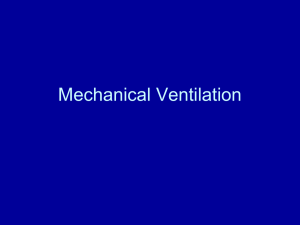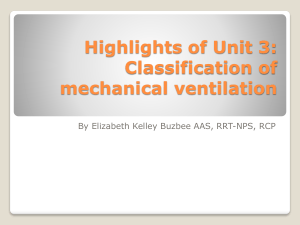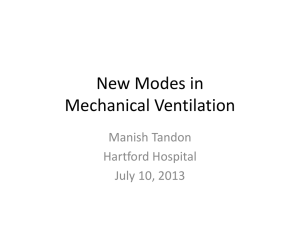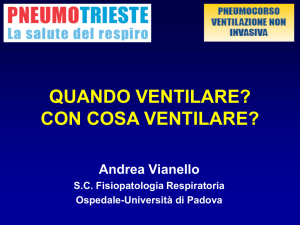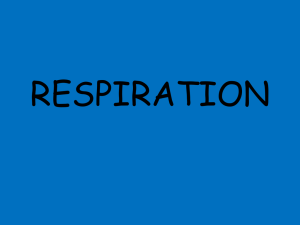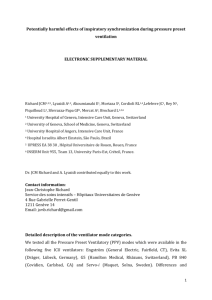File - Respiratory Therapy Files
advertisement
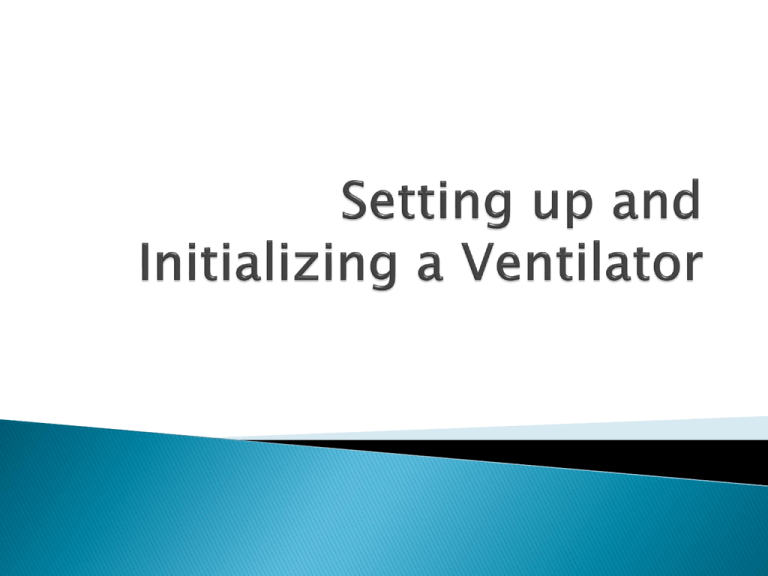
Before you can begin mechanical ventilation your ventilator must be correctly assembled ◦ Step 1: Assemble expiratory and inspiratory filters on the ventilator. (ventilators vary, so this process will also vary and be taught during lab) ◦ Step 2:Attach circuit to ventilator. Acute ventilator circuits will have an inspiratory limb and an expiratory limb so that the circuit is unbroken and the patients returned volumes are assessed on the vent. (long term vents typically have a inspiratory limb only) A expiratory filter with H2O trap for condensation- this is for the 840 ventilator. Attached to the ventilator, prevents H2O from entering the machine A inspiratory filter, attached to the vent and inspiratory limb, prevents small particulates from the machine to the patient Pressure line To pt Pt exhalation Subacute/long term vent circuit, the patients exhalation does not go back into the ventilator. Uses a separate pressure line Heater probe inlet Expiratory limb Extra tubing for heater To Pt Wye Inspiratory limb Heater probe inlet Step 3: Once circuit is attached, close all open ports on the circuit. Circuits have ports for heated humidification temperature probes If circuit is a heated circuit attach humidifier and probes Most adult ventilators are setup with an HME initially. All neonatal and pediatric circuits are setup with heated humidifiers with heated circuits If you setup a heater, but do not have a heated circuit, you must use water traps inline to catch the condensation that will develop Water trap Non-heated circuit with water traps HME, placed at Wye Passover heated Concha Heater. Heats up a metal column water Ventilator circuits are age specific. For an adult you must use an adult circuit, pediatric and neonates have specific circuits as well Neonatal and Pediatric circuits are always heated circuits- meaning they have a coil inside to maintain temperature during humidification Depending on the ventilator used some circuits will have a pressure line inlet attached to the machine and/or a flow sensor adapter Ventilator circuits should not be changed routinely for infection control purposes, however you can change a circuit if soiled Circuits are sterile, meaning you should not insert a younker inside the circuit to remove secretions. Once the circuit is attached you can now plug in the electrical and air/O2 connections to your ventilator… Ventilators are electrically powered and pneumatically driven Long term vent Transport vent with O2/Air cylinders The use of closed suction catheters should be considered part of a VAP prevention strategy, and they do not need to be changed daily for infection control purposes. The maximum duration of time that closed suction catheters can be used safely is unknown Use only inline suction ballards on vents. They make ETT and Trach sizes Once your circuit, filters and humidification is on and your vent is plugged in to electricity and Air and O2, you can now do the pre-use calibration This varies greatly with all ventilators, but generally you start by turning on your vent (remember, most vents you will take off the stopper at the WYE when you first turn on the vent) Once the vent is on you choose SST (short self test) option to run the calibration The calibration will assess the circuits compliance/elastance, check for leaks and proper flow http://www.youtube.com/watch?v=4p0SppVb GMs Once it has been determined a patient requires a ventilator you must now attach them and apply the proper settings. When you first turn on the ventilator you will press either “new patient” or “same patient”, verbiage will vary. Most new vents will save the previous settings in case you transfer a patient and reattach them During the setup the patient is typically being bagged. The MD may or may not give you the settings. Mode is AC, SIMV or CPAP ◦ Assist control (no breathing, or inadequate breathing, patient sedated…) ◦ SIMV (same reasons as AC, but you expect patient will breathe spontaneously soon, post ops) ◦ Spontaneous/CPAP: Patient is breathing spontaneously ◦ http://www.youtube.com/watch?v=IUZ3Plmz_YQ&f eature=related PCV: Used for patients where you want to control their pressure limit, set on AC or SIMV ◦ Set inspiratory pressure limit, I-time, FIO2, PEEP, Rate VC: Used in most patients, control minute volume, set on AC or SIMV ◦ Set tidal volume, flow, FIO2, PEEP, rate PRVC: Becoming a common mode for most patients, limits pressure and gives a minimum volume, set on AC or SIMV ◦ Set minimum VT, pressure limit, FIO2, rate, peep, Itime Once you decide what mode and breath type, next you input the settings. VT: set in VC mode, based on IBW, normal range 8-12 ml/kg, restrictive lungs 5-7 ml/kg Flow: Set to give an appropriate I:E ratio, typically 40-60 LPM, set higher for COPD patients, watch for airtrapping Pressure Limit: set to achieve an acceptable VT, typically set between 15-25 cmH2O I-time: Decrease when rate is set high, otherwise start around 0.8-1 second Rate: Initial rates are 8-12 per min. If you suspect or know patient has high PaCO2 you may start higher FIO2: typically set at 100% if it’s a new patient and you do not know their PaO2, otherwise set per patients FIO2 before vent if it was acceptable PEEP: typically started at 0, and added once FIO2 is at 60% and patient has refractory hypoxemia, then initiate at 5 Pressure Support: If you started in CPAP or SIMV mode, you will set a PSV. Typically around 10-12 cmH2O, but give to increase spontaneous Vte to acceptable ranges and give enough to over come RAW Sensitivity: Set as either flow or pressure. In either one it is set between 0.5-3, the higher this number the harder it is for the patient to trigger the breath, the lower =auto trigger Flow pattern: In VC mode you can choose how the set flow will be delivered to the patient. Either as a constant flow (Square) or as a decelerating pattern. In PC and PRVC the flow is not set, so the pattern in always decelerating. A constant flow will increase MAP, this will increase oxygenation but increase PIP Any time it is desired to limit inspiratory pressure. High PIPs Low Pa02 Need high, variable flow rates Goals in ARDS ARDS goal - control/minimize lung damage Literature suggests – low alveolar pressure / low Vt strategy – recently more concerned with lung damage caused by over distention – preventing repeated collapse and reopening of alveoli Treating ARDS What are your goals for these patients? – O2 delivery – oxygenation is more affected by MAP – PCV, BiLevel, or APRV may be a better way to approach these patients peak airway pressure and MAP is controlled oxygenation is favored ventilation is sacrificed if it conflicts with controlling pressure Pressure Control is time cycled. Rapid rise to set pressure and pressure is maintained for the duration of the inspiratory time. Inspiratory plateau promotes alveolar recruitment and oxygenation. F E B 11 1996 W A V E F O R M M O N IT O R IN G 30 30 P A T IE N T ID 98787987 13:50 Pressure PressureTime TimeCurve Curve Volume Pressure Volume Expiration Inspiratory Time PPawaw SSec ec cm H 2 020 cmH 11 22 33 . V -10 A C C E S S F U N C T IO N 60 T O C H A N G E O R E X IT W A V E FO R M S 44 55 66 Use the plateau pressure obtained during volume ventilation as a starting point (if you started in VC first) Adjust pressure to obtain desired Vt in the range of 5 – 8 cc/kg “B” Represents Inspiratory Pressure “A” represents PEEP T V LITERS .6 A B .4 “C” = Upper Inflection point .2 aw P cmH 0 2 “D” = Lower Inflection Point 60 40 20 0 20 40 60 Setting I-Time in PCV Observing the Flow and Tidal Volume Time curve during PCV can help determine adequate inspiratory time. Observing the Pressure Time curve will assist in determining if the I -Time is too long 450cc 600 cc VT SEC 0 -20 120 1 2 3 4 5 6 . SEC V 1 LPM 120 2 3 4 5 6 450cc 600 cc 500cc VT SEC 0 -20 120 1 2 3 4 5 6 Lost VT . SEC V 1 LPM 120 2 3 4 5 6 30 Assessing correct Inspiratory Time in PCV Optimal Paw Sec cmH20 1 2 3 4 Too Long -10 Answer - Inspiratory time set too long Patient is starting to exhale prematurely. 5 6 Flow x Time = Volume Increasing the I time can increase the Vt. Try this before increasing the inspiratory pressure. Watch for I time too long, causing auto peep and dyschrony. Keep I time constant to maintain more stable tidal volumes The Pressure Control Mode Pressure Control – Set high pressure = PI PI is PEEP compensated and changes as PEEP level changes – Set low pressure = PEEP – Set breath timing parameters = TI, TE, I:E ratio Pressure Control Rise TIme Commonly referred to as rise %, or rise time Available in all pressure breaths (PC, PS, and spontaneous) Tailors inspiratory rise to match patient demand. Does not change I time. Rise Time % Commonly referred to as rise %, or rise time Tailors inspiratory rise to match patient demand Rise Time % Transient Overshoot FAP = 1 = 100 FAP = 50 FAP Pressure Relief Expiratory Sensitivity (ESens) Peak Inspiratory Flow V 40% 20% 5% T
